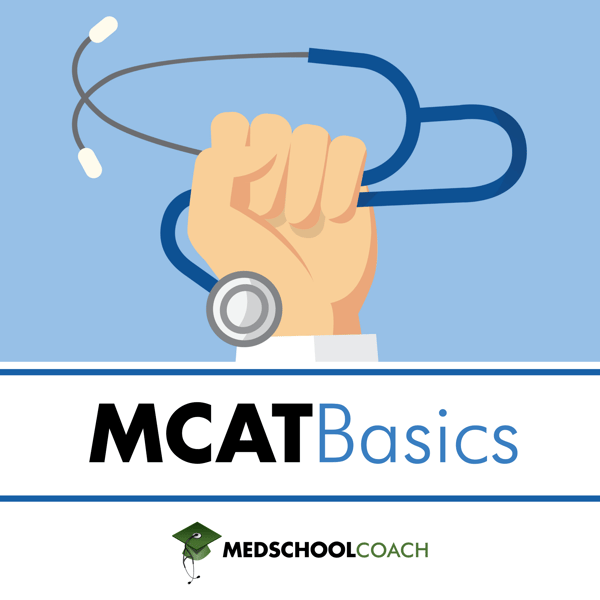Gluconeogenesis
MCAT Basics (from MedSchoolCoach)
MedSchoolCoach
4.6 • 612 Ratings
🗓️ 17 October 2024
⏱️ 22 minutes
🧾️ Download transcript
Summary
One of the body's key survival mechanisms is gluconeogenesis, a vital metabolic process, and the body's clever way of making glucose when supplies are low.
On this episode of the MCAT Basics podcast, guest host Alex Starks walks through the process of gluconeogenesis. He explains how the body generates glucose when levels drop. Highlighting the liver's role, Alex explains how amino acids, lactate, and glycerol are converted into glucose. The episode also touches on the energy demands of the process and why muscle cells aren't involved in gluconeogenesis.
Visit medschoolcoach.com for more help with the MCAT.
Jump into the conversation:
(00:00) Intro
(02:15) Overview of glucose metabolism and glycogen storage
(03:37) The liver’s role in maintaining blood glucose levels
(05:11) Glucogenic amino acids and their role in glucose production
(06:06) Conversion of alanine and glutamine to pyruvate
(06:53) Lactate and the Cori cycle
(07:34) Glycerol from triglycerides entering gluconeogenesis
(08:27) The first bypass reaction: Pyruvate to oxaloacetate
(09:55) The role of mitochondria and the malate-aspartate shuttle
(11:00) Phosphoenolpyruvate formation and energy requirements
(12:16) Steps of gluconeogenesis and ATP consumption
(13:38) The second bypass reaction: Fructose 1,6-bisphosphate to fructose 6-phosphate
(14:16) The third bypass reaction: Glucose 6-phosphate to glucose
(15:31) Gluconeogenesis regulation and the role of glucagon
(17:10) Quiz
Transcript
Click on a timestamp to play from that location
| 0:00.0 | Welcome to MCAT Basics, your ultimate guide to the essential topics you need to master for the MCAT, |
| 0:06.2 | brought to you by the physicians at med school coach. Every week, Sam Smith breaks down high-yield |
| 0:11.5 | MCAT topics, ensuring you're primed for success on test day. Join Sam as we explore the most |
| 0:17.2 | crucial subjects outlined by the AAMC pulled from official practice materials |
| 0:21.6 | and third-party resources. |
| 0:23.4 | Get ready to elevate your MCAT game with topics tailored to maximize your score potential. |
| 0:28.7 | Today's guest host is Alex Starks. |
| 0:31.8 | So far, I hope car metabolism has seemed relatively straightforward as we followed the story |
| 0:36.2 | of glucose through glycolysis, |
| 0:37.8 | through the citric acid cycle, and even into the electron transport chain. |
| 0:41.7 | But what about when we're low on glucose? |
| 0:43.8 | Well, today we're going to start to explore that, and I'm going to touch on date pictures |
| 0:47.6 | in gluconeogenesis, including central mechanisms in hormonal control on the organismal level, |
| 0:53.3 | as well as what's happening on the cellular |
| 0:55.0 | and molecular levels. |
| 1:01.0 | All right, so we'll start at the zoomed-out level. |
| 1:05.0 | So as humans, our body can solve the problem of low glucose, and that's not just low cellular glucose, but also low |
| 1:12.5 | glucose in the bloodstream, by simply making more glucose. Hence the name of our topic, |
| 1:17.8 | gluconeogenesis, which really just means new glucose. Of course, we can't use glucose to make |
| 1:24.8 | glucose. That would be nonsense. So we have to create glucose using non-carbohydrate materials. |
| 1:30.5 | So this point is very important and helpful because a process like the conversion of |
| 1:34.7 | galactose into glucose or glycogen into glucose is not considered gluconeogenesis. |
... |
Please login to see the full transcript.
Disclaimer: The podcast and artwork embedded on this page are from MedSchoolCoach, and are the property of its owner and not affiliated with or endorsed by Tapesearch.
Generated transcripts are the property of MedSchoolCoach and are distributed freely under the Fair Use doctrine. Transcripts generated by Tapesearch are not guaranteed to be accurate.
Copyright © Tapesearch 2025.

